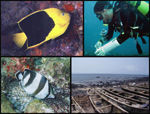
ABSTRACT
The aim was to understand why and when areas of endemism (provinces) of the tropical Atlantic Ocean were formed, what processes have contributed to faunal enrichment, and how they relate to each other. The distributions of 2605 species of reef fishes were compiled for 25 areas of the Atlantic and southern Africa. Maximum parsimony and distance analyses were employed to investigate biogeographical relationships among those areas. A collection of 26 phylogenies of various Atlantic reef fish taxa was used to assess patterns of origin and diversification relative to evolutionary scenarios based on spatio-temporal sequences of species splitting produced by geological and palaeoceanographic events. We present data on faunal (species and genera) richness, endemism patterns, diversity buildup (i.e. speciation processes), and discuss the operation of the main biogeographic barriers and/or filters. The phylogenetic (proportion of sister species) and distributional patterns (number of shared species) are generally concordant with recognized biogeographic provinces in the Atlantic. The highly uneven distribution of species in certain genera appears to be related to their origin, with highest species richness in areas with the greatest phylogenetic depth. Diversity buildup in Atlantic reef fishes involved (1) diversification within each province, (2) isolation as a result of biogeographic barriers, and (3) stochastic accretion via dispersal between provinces. The timing of divergence events is not concordant among taxonomic groups. The three soft (non-terrestrial) inter-regional barriers (mid-Atlantic, Amazon, and Benguela) clearly act as “filters” by restricting dispersal but at the same time allowing occasional crossings that apparently leads to the establishment of new populations and species. Fluctuations in the effectiveness of the filters, combined with ecological differences among provinces, apparently provide a mechanism for much of the recent diversification of reef fishes in the Atlantic. Our dataset indicates that both historical events (e.g. Tethys closure) as well as relatively recent dispersal (with or without further speciation) have had a strong influence on Atlantic tropical marine biodiversity and have contributed to the biogeographic patterns we observe today, however, examples of the latter process outnumber the former.